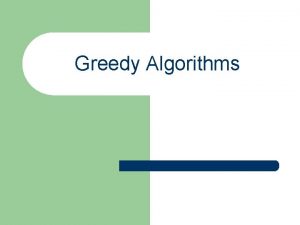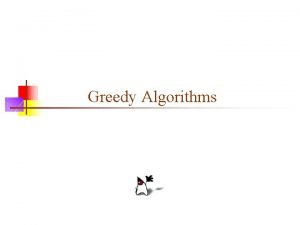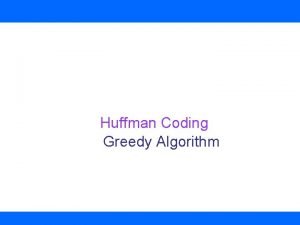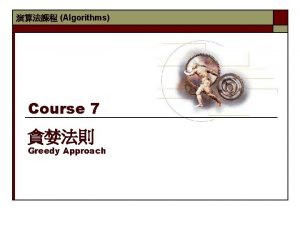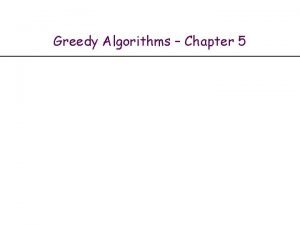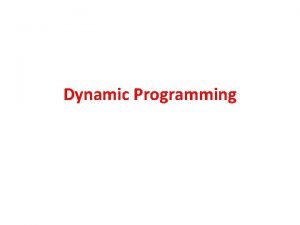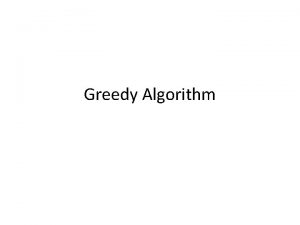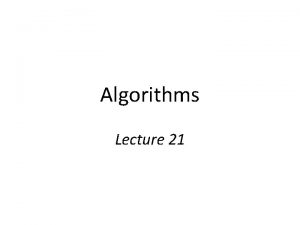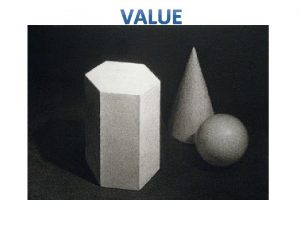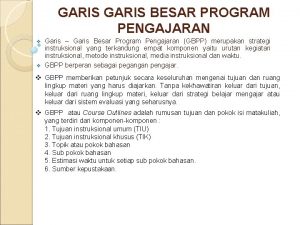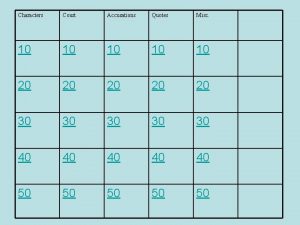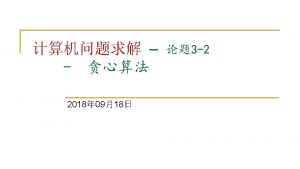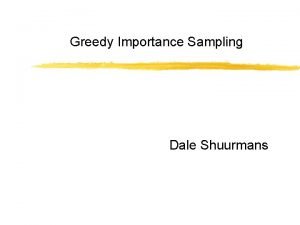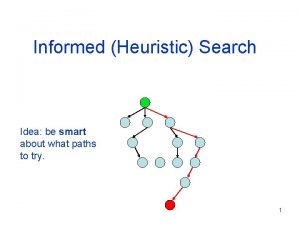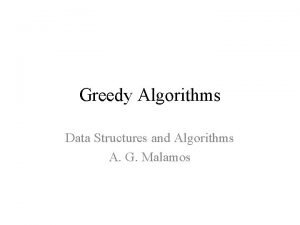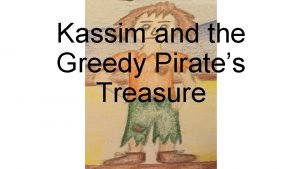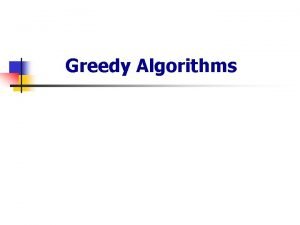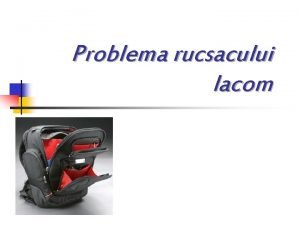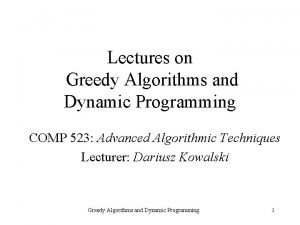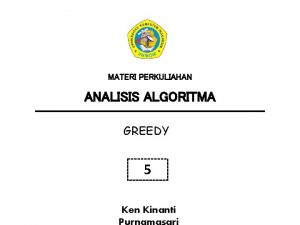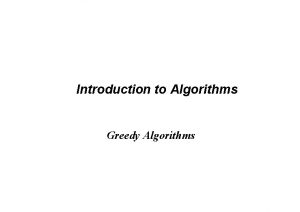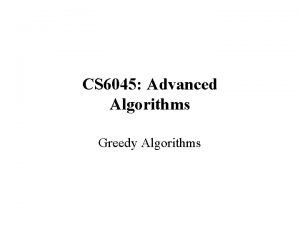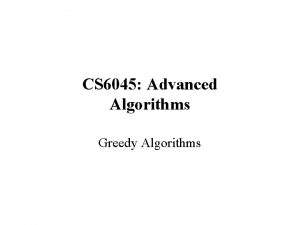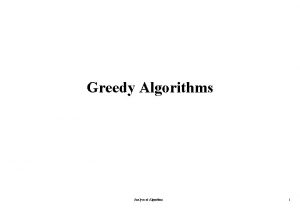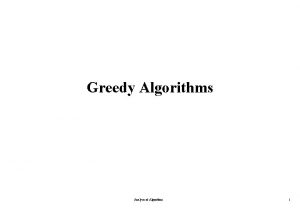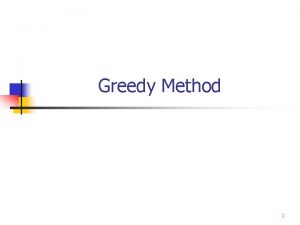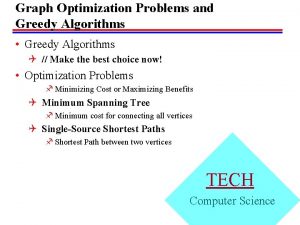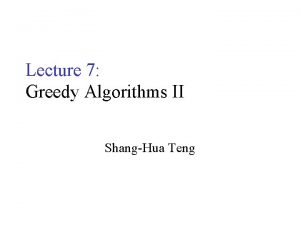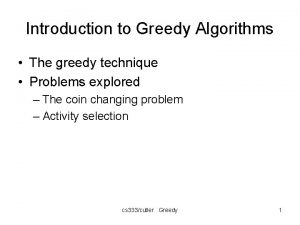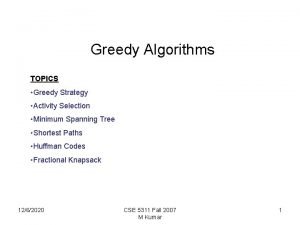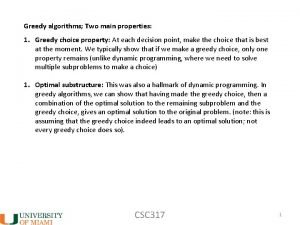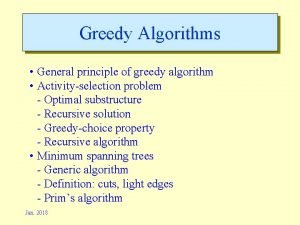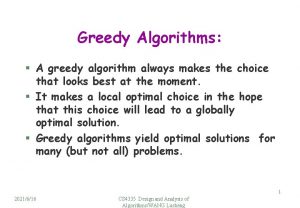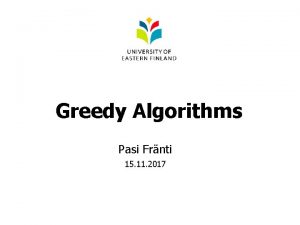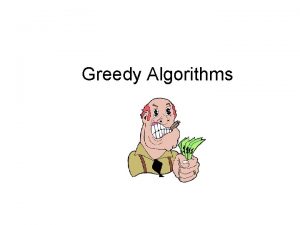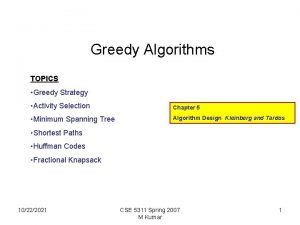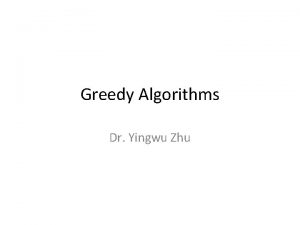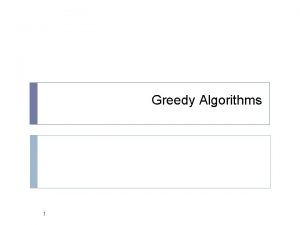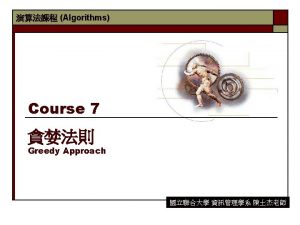Algorithms Course 7 Greedy Approach 2 Outlines u









![10 u [Note]: n n n S中的V等於G中的V 若G 不連通 (not connected),則G無Spanning Tree connected G中的Spanning 10 u [Note]: n n n S中的V等於G中的V 若G 不連通 (not connected),則G無Spanning Tree connected G中的Spanning](https://slidetodoc.com/presentation_image_h/d690b96c01368e754c1e04bbd52ae7c1/image-10.jpg)







































![50 u Dijkstra’s Algorithm觀念圖解: v DIST[w] DIST[u] w Cost[u][w] u 50 u Dijkstra’s Algorithm觀念圖解: v DIST[w] DIST[u] w Cost[u][w] u](https://slidetodoc.com/presentation_image_h/d690b96c01368e754c1e04bbd52ae7c1/image-50.jpg)





- Slides: 55

演算法課程 (Algorithms) Course 7 貪婪法則 Greedy Approach

2 ▓ Outlines u 本章重點 n n n Dynamic Programming v. s. Greedy Approach Concepts of Greedy Approach Minimum Spanning Trees The Greedy Approach versus Dynamic Programming: The Knapsack Problem Dijkstra Algorithm for Single-pair Shortest Path Problem






8

![10 u Note n n n S中的V等於G中的V 若G 不連通 not connected則G無Spanning Tree connected G中的Spanning 10 u [Note]: n n n S中的V等於G中的V 若G 不連通 (not connected),則G無Spanning Tree connected G中的Spanning](https://slidetodoc.com/presentation_image_h/d690b96c01368e754c1e04bbd52ae7c1/image-10.jpg)
10 u [Note]: n n n S中的V等於G中的V 若G 不連通 (not connected),則G無Spanning Tree connected G中的Spanning Tree不只一個 若|V|=n,則|F| = n-1 同一G中的任二個不同之Spanning Tree不一定有交集的邊存在 不一定有交集的邊 ¡ Ex: A B E C D A A B E C D



13 u 試利用Kruskal’s Algo. 求下圖的Minimum Spanning Tree


15



18 u 試利用Prim’s Algo. 求下圖的Minimum Spanning Tree

19 Sol: Y V-Y {1} {2, 3, 4, 5} {1, 2} {3, 4, 5} {1, 2, 3} {4, 5} {1, 2, 3, 5} {4} {1, 2, 3, 4, 5} {} ∵Y = V, ∴ Stop Set F

20 Time Complexity: O(n 2)



23 u Knapsack n n Problem可分成兩種問題型態: Fractional Knapsack Problem: Problem ¡ 物品可被切割,亦即取物時可取部份 ¡ 採用Greedy Approach 0/1 Knapsack Problem: Problem ¡ 物品不可被切割,亦即取物時得取全部 ¡ 採用Dynamic Programming






29 ※練習範例※ u Now, you are inside a Buffet restaurant. Assume that your stomach can only accept food with maximum size M and there are n kinds of food with sizes and values as (s 1, v 1), (s 2, v 2), …, (sn, vn), in the restaurant. Design an algorithm to find the highest value of food that you can eat. Only need to demonstrate your algorithm based on the case: M = 22 and 4 kinds of food with (3, 4), (4, 5), (6, 9), (8, 13). n Hint: this is equivalent to the knapsack problem. (91年交大 資 所) Ans: 取食物的順序: 4, 3, 1, 2,其餘部份請自行說明。


31




35 假設有一背包W = 5,考慮以下的Items,求0/1 Knapsack最佳解: u 範例: Sol: n P Item 重量 利潤 O 1 1 $6 O 2 2 $10 O 3 3 $12 先建立P[0…n, 0…W]和label[0…n, 0…W]兩個Table 0 1 2 3 4 5 label 0 0 1 1 2 2 3 3 0 1 2 3 4 5




39 Item O 1 O 2 O 3 重量 1 2 3 n 利潤 $6 $10 $12 if i = 0 or k = 0 if k < w i ì 0 ï P[i, k] = í P[i - 1, k] ï Max(p + P[i - 1, k - w ], P[i - 1, k]) î i i if k ³ w i Step 4: 當 i = 3,表示有 3 個物品可以拿 (即: O 1 、 O 2 與O 3)。 ¡ ∵k = 3 ,表示負重3; 此時: P 0 1 2 3 4 5 label 0 1 2 3 4 5 0 0 0 0 ø ø ø 1 0 6 6 6 1 ø {1} {1} {1} 2 0 6 10 16 16 16 2 ø {1} {2} 3 0 6 10 16 {1, 2} 3 ø {1} {2} {1,

40 Item O 1 O 2 O 3 重量 1 2 3 利潤 $6 $10 $12 ì 0 ï P[i, k] = í P[i - 1, k] ï Max(p + P[i - 1, k - w ], P[i - 1, k]) î i i ¡ ∵k = 4 ,表示負重4; 此時: ¡ ∵k = 5 ,表示負重5; 此時: if i = 0 or k = 0 if k < w i if k ³ w i P 0 1 2 3 4 5 label 0 1 2 3 4 5 0 0 0 0 ø ø ø 1 0 6 6 6 1 ø {1} {1} {1} 2 0 6 10 16 16 16 2 ø {1} {2} 3 0 6 10 16 18 22 {1, 2} 3 ø {1} {2} {1, {2,

41




45



48 1 0 S 1 狀態 頂點選擇 u Initial DIST 2 3 4 5 6 7 8 10 0 1 0 1 0 01 1 0 1 1 2 3 4 5 6 7 8 5 1500 0 250 1 6 1250 0 250 1150 1650 2 7 2450 1250 0 250 1150 1650 3 4 2450 1250 0 250 1150 1650 4 8 3350 2450 1250 0 250 1150 1650 5 3 3350 3250 2450 1250 0 250 1150 1650 6 2 3350 3250 2450 1250 0 250 1150 1650 7 1 3350 3250 2450 1250 0 250 1150 1650

![50 u Dijkstras Algorithm觀念圖解 v DISTw DISTu w Costuw u 50 u Dijkstra’s Algorithm觀念圖解: v DIST[w] DIST[u] w Cost[u][w] u](https://slidetodoc.com/presentation_image_h/d690b96c01368e754c1e04bbd52ae7c1/image-50.jpg)
50 u Dijkstra’s Algorithm觀念圖解: v DIST[w] DIST[u] w Cost[u][w] u





 What is greedy
What is greedy N/a greedy
N/a greedy Huffman code greedy algorithm
Huffman code greedy algorithm Fractional knapsack problem
Fractional knapsack problem Interval scheduling greedy
Interval scheduling greedy Greedy divide and conquer dynamic programming
Greedy divide and conquer dynamic programming Greedy bank method
Greedy bank method Straightforward algorithm
Straightforward algorithm Greedy approach
Greedy approach A haunted house by virginia woolf analysis
A haunted house by virginia woolf analysis Kairos talk outlines
Kairos talk outlines Outline of the book of acts by chapter
Outline of the book of acts by chapter Sermon outlines on the shunammite woman
Sermon outlines on the shunammite woman Visible outlines
Visible outlines Ksf outlines
Ksf outlines Foley v classique coaches
Foley v classique coaches Exegetical sermon outlines
Exegetical sermon outlines Anima outline
Anima outline Acute suppurative appendicitis
Acute suppurative appendicitis What is coordination in outlining
What is coordination in outlining Mucoepidermoid carcinoma histology
Mucoepidermoid carcinoma histology Four main components for effective outlines
Four main components for effective outlines Cjis security policy
Cjis security policy Two types of outlines
Two types of outlines A clear concise document which outlines preventive
A clear concise document which outlines preventive Lesson outline for teaching
Lesson outline for teaching Cmmi model outlines
Cmmi model outlines Pyelonephritis
Pyelonephritis A business plan is a document that outlines
A business plan is a document that outlines Mun position paper outline
Mun position paper outline Half brick wall vs one brick wall
Half brick wall vs one brick wall Course title and course number
Course title and course number Chaine parallèle muscle
Chaine parallèle muscle Deep learning approach and surface learning approach
Deep learning approach and surface learning approach Datagram network and virtual circuit network
Datagram network and virtual circuit network Cognitive approach vs behavioral approach
Cognitive approach vs behavioral approach Cognitive approach vs behavioral approach
Cognitive approach vs behavioral approach Approach meaning in research
Approach meaning in research Fine grained screening
Fine grained screening Diagram for traditional approach
Diagram for traditional approach Multiple approach avoidance conflict
Multiple approach avoidance conflict Thomas putnam accusations quotes
Thomas putnam accusations quotes Activity selection problem greedy algorithm
Activity selection problem greedy algorithm Qallow
Qallow Greedy algoritmus
Greedy algoritmus Greedy search
Greedy search Greedy method in data structure
Greedy method in data structure Captain kassim
Captain kassim Greedy vs dynamic programming
Greedy vs dynamic programming Greedy algorithm
Greedy algorithm Greedy algorithm
Greedy algorithm Greedy chicken
Greedy chicken Rezolvare
Rezolvare Kassim and the greedy dragon
Kassim and the greedy dragon Greedy algorithm time complexity
Greedy algorithm time complexity Jurnal algoritma greedy
Jurnal algoritma greedy
